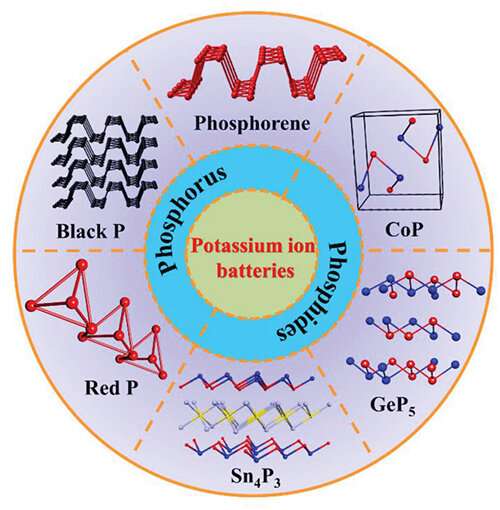Schematic illustration of the phosphorus-based composites as anode materials for KIBs. Credit: WU Ying and HUANG Haibo
Prof. WU Zhongshuai from the Dalian Institute of Chemical Physics (DICP) of the Chinese Academy of Sciences, in collaboration with Prof. YU Yan from the University of Science and Technology of China, reviewed the recent progress of phosphorus-based composites as anode materials for potassium-ion batteries (KIBs), and shared new insights on existing challenges and opportunities for designing high-performance phosphorus-based anodes for KIBs. This review was published in Advanced Materials.
Potassium-ion batteries (KIBs) are very promising core energy storage devices that can meet the increasing needs for scalable and affordable stationary applications due to their advantages of low-cost and earth-abundant potassium.
Although the KIBs hold tremendous potential, there are still challenges for KIBs resulting from the instability of materials upon insertion/extraction of large K+, accompanied with poor cyclability and low initial coulombic efficiency.
As the key to optimizing a battery's performance, the development of high-performance electrode materials helps to increase the feasibility of KIBs technology. In this sense, phosphorus-based materials (i.e., phosphorus and metal phosphide) with high theoretical capacity and low redox potential tick all the right boxes of choosing materials.
This review gave a rapid glimpse at recent studies on phosphorus-based anode materials for advanced KIBs, covering the synthetic methods, reaction mechanisms, electrochemical properties and performances.
In addition, several promising strategies were highlighted to address the imminent challenges faced by phosphorus-based anode materials, hoping to cast an insightful outlook for possible future direction in this field.
More information: Ying Wu et al. The Promise and Challenge of Phosphorus‐Based Composites as Anode Materials for Potassium‐Ion Batteries, Advanced Materials (2019). DOI: 10.1002/adma.201901414
Journal information: Advanced Materials
Provided by Chinese Academy of Sciences
























